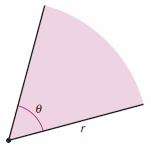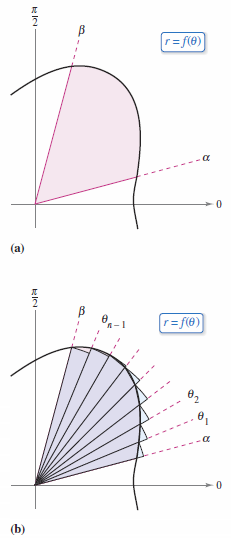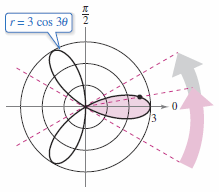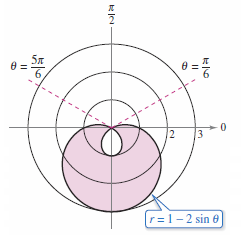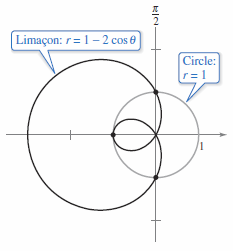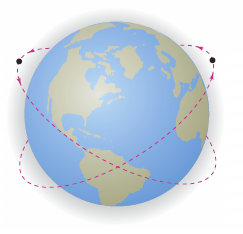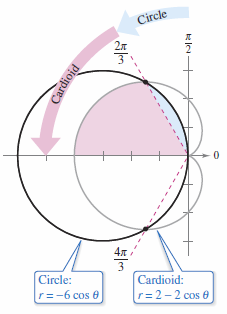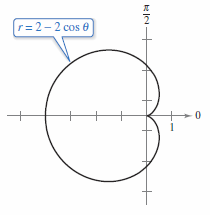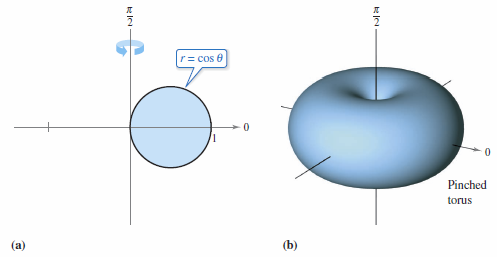Calculus II 10.05 Area and Arc Length in Polar Coordinates
| Previous | Calculus II 10.04 Polar Coordinates and Polar Graphs |
| Next | Calculus II 10.06 Polar Equations for Conics and Kepler's Laws |
Contents
10.5 Area and Arc Length in Polar Coordinates
- Find the area for a region bounded by a polar graph.
- Find the intersection points between two polar graphs.
- Find the arc length for a polar graph.
- Find the area for a rotated surface in polar form.
Area for a Polar Region
|
|
Calculating the area for a polar region parallels that for a rectangular region but uses circle sectors, pie slices, rather than rectangles, brownie slices. Try comparing the area between a Neapolitan Pizza[1] and a Sicilian Pizza[2]. The area for a circle sector with radius \(r=1/2 \theta r^{2}\) measured in radians, is shown in Figure 10.5.1. Consider the function \(r=f(\theta)\), where \(f\) is continuous and nonnegative on the interval \(\alpha \leqslant \theta \leqslant \beta \). The region bounded by the graph for \(f\) and the radial lines \(\theta=\alpha\) and \(\theta = \beta\) is shown in Figure 10.5.2(a). To find the area for this region partition the interval \([\alpha,\beta]\) into \(n\) equal subintervals
Then approximate the area by summing the area for each sector, as shown in Figure 10.5.2(b).
Taking the limit as \(n \to \infty\) produces
Which leads to Theorem 10.5.1. |
Theorem 10.5.1 Area in Polar Coordinates
If \(f\) is continuous and nonnegative over the interval \([\alpha, \beta]\), \(0 < \beta - \alpha \leqslant 2 \pi\), then the area for the region bounded by the graph for \(r=f(\theta)\) between the radial lines \(\theta=\alpha\) and \(\theta = \beta\) is
| \(A\) | $$= \frac{1}{2} \int_{\alpha}^{\beta} [f(\theta)]^{2} \:d \theta$$ | |
| $$= \frac{1}{2} \int_{\alpha}^{\beta} r^{2} \:d\theta$$ | \(\:\:\:\: \color{red}{0 < \beta - \alpha \leqslant 2 \pi} \) |
This works on a continuous nonpositive function. The formula is not necessarily valid, however, when \(f\) takes on both positive and negative values on the interval \([\alpha, \beta]\).
Example 10.5.1 Finding the Area for a Polar Region
|
|
Find the area for one petal on the rose curve \(r=3 \cos 3 \theta\).
Integrating between 0 and \(2\pi\) will not produce the area for all three petals. The result is \(9\pi/2\), twice the actual area. The duplication occurs because the rose curve is traced twice as \(\theta\) increases from 0 to \(2 \pi\). |
Example 10.5.2 Finding the Area Bounded by a Single Curve on a Limaçon[3]
|
|
Find the area for the region lying between the limaçon's inner and outer loops. The limaçon's formula is \(r=1-2 \sin \theta\).
In a similar way \(\theta\) can be integrated from \(5\pi/6\) to \(13\pi/6\) to find the area for the outer loop is \(A_{2}=2\pi+(3 \sqrt{3}/2)\). The are between the loops is the difference between \(A_{2}\) and \(A_{1}\).
|
Intersection Points between Two Polar Graphs
|
|
Because a point may be represented in different ways in polar coordinates, care must be taken in determining the intersecting points between two polar graphs. For example, consider the intersecting points between the graphs for
as shown in Figure 10.5.5. Finding intersecting points in cartesian equations is done by solving an equation system simultaneously.
The corresponding intersecting points are \((1,\pi/2)\) and \((1,3\pi/2)\). Figure 10.5.5 shows a third intersection point. Thus, always remember to sketch the graph. The third point was not found because it has different coordinates in both graphs.
An additional complication is the pole is represented by \((0,\theta)\) where \(\theta\) is any angle. Check for agreement a between the poles for the graphs. A similar problem is finding collision points with two satellites in intersecting orbits about the Earth, as shown in Figure 10.5.6. The satellites will not collide as long as they reach the intersecting points at different times, \(\theta\) values. Collisions will occur only at simultaneous points --those that are reached at the same time, \(\theta\) values. | ||||||||||||||||||||
Example 10.5.3 Finding the Area Between a Cardioid and a Circle
|
Find the area common to these curves.
Solution Because both curves are symmetric with respect to the \(x\)-axis calculate for the upper half-plane, as shown in Figure 10.5.7. The blue shaded region lies between the circle and the radial line \(\theta = 2\pi/3\). Because the circle has coordinates \((0,\pi/2)\) at the pole, integration between \(\pi/2\) and \(2\pi/3\) will yield the area. The red shaded region lies between the cardioid and the radial lines \(\theta=2\pi/3\) and \(\theta=\pi\). Find this area by integrating between \(2\pi/3\) and \(\pi\). Add both integrals to find the common area lying above the radial line \(\theta=\pi\). Then multiply by 2 to find the total area.
Multiplying by 2 produces
|
Arc Length in Polar Form
The formula for a polar arc's length can be obtained from the arc length formula for a curve described by parametric equations as described in Theorem 10.5.2.
Theorem 10.5.2 Arc Length for a Polar Curve
Let \(f\) be a function whose derivative is continuous on an interval \(\alpha \leqslant \theta \leqslant \beta \). Let \(r=f(\theta)\) be a parametric equation from \(\theta=\alpha\) to \(\theta=\beta\). The length for the graph is
- $$S= \int_{\alpha}^{\beta} \sqrt{ [f(\theta)]^{2} + [f{}^{\prime}(\theta)]^{2}}\:d\theta=\int_{\alpha}^{\beta} \sqrt{r^{2}+ \left(\frac{dr}{d\theta} \right)^{2} } \:d\theta$$
Example 10.5.4 Finding the Length for a Polar Curve
|
Find the arc length from \(\theta=0\) to \(\theta=2\pi\) for the cardioid
as shown in Figure 10.5.8.
|
Area for a Rotated Surface
The polar coordinate formula for a rotated surface are are drawn from the parametric versions given in Theorem 10.3.3, using the equations \(x=r \cos \theta\) and \(y= r \sin \theta\) and described in Theorem 10.5.3.
Theorem 10.5.3 Area for a Rotated Surface in Polar Form
Let \(f\) be a function whose derivative is continuous on an interval \(\alpha \leqslant \theta \leqslant \beta \). The area for a rotated surface formed by revolving the graph \(r=f(\theta)\) from \(\theta=\alpha\) to \(\theta=\beta\) about a line is: $$1.\:S=2\pi \int_{\alpha}^{\beta} f(\theta) \sin \theta \sqrt{ [f(\theta)]^{2} + [f{}^{\prime}(\theta)]^{2}}\:d\theta \:\:\:\: \color{red}{ \text{ About the polar axis}}$$ $$2.\:S=2\pi \int_{\alpha}^{\beta} f(\theta) \cos \theta \sqrt{ [f(\theta)]^{2} + [f{}^{\prime}(\theta)]^{2}}\:d\theta \:\:\:\: \color{red}{ \text{About the line }\theta=\frac{\pi}{2} }$$
Example 10.5.5 Finding the Area for a Rotated Surface
Find the area for the rotated surface formed by revolving the circle, \(r=f(\theta)= \cos \theta\), about the line \(\theta=\pi/2\), as shown in Figure 10.5.9.
Solution Use the second formula in Theorem 10.5.3 with \(f{}^{\prime}(\theta)=-\sin \theta\). Tracing the circle as \(\theta\) increases from 0 to \(\pi\) produces
| $$S$$ | $$=2\pi \int_{0}^{\pi} \cos \theta (\cos \theta) \sqrt{ \cos^{2} \theta + \sin^{2} \theta }\:d\theta $$ | Insert values into Theorem 10.5.3 |
| $$=2\pi \int_{0}^{\pi} \cos^{2} \theta \:d\theta $$ | Trigonometric identity | |
| $$=\pi \int_{0}^{\pi} (1+\cos 2 \theta) \:d\theta $$ | Trigonometric identity | |
| $$=\pi \left[ \theta + \frac{\sin \theta}{2} \right]_{0}^{\pi} = \pi^{2}$$ |
Internal Links
Parent Article: Calculus II 10 Conics Parametric Equations and Polar Coordinates
